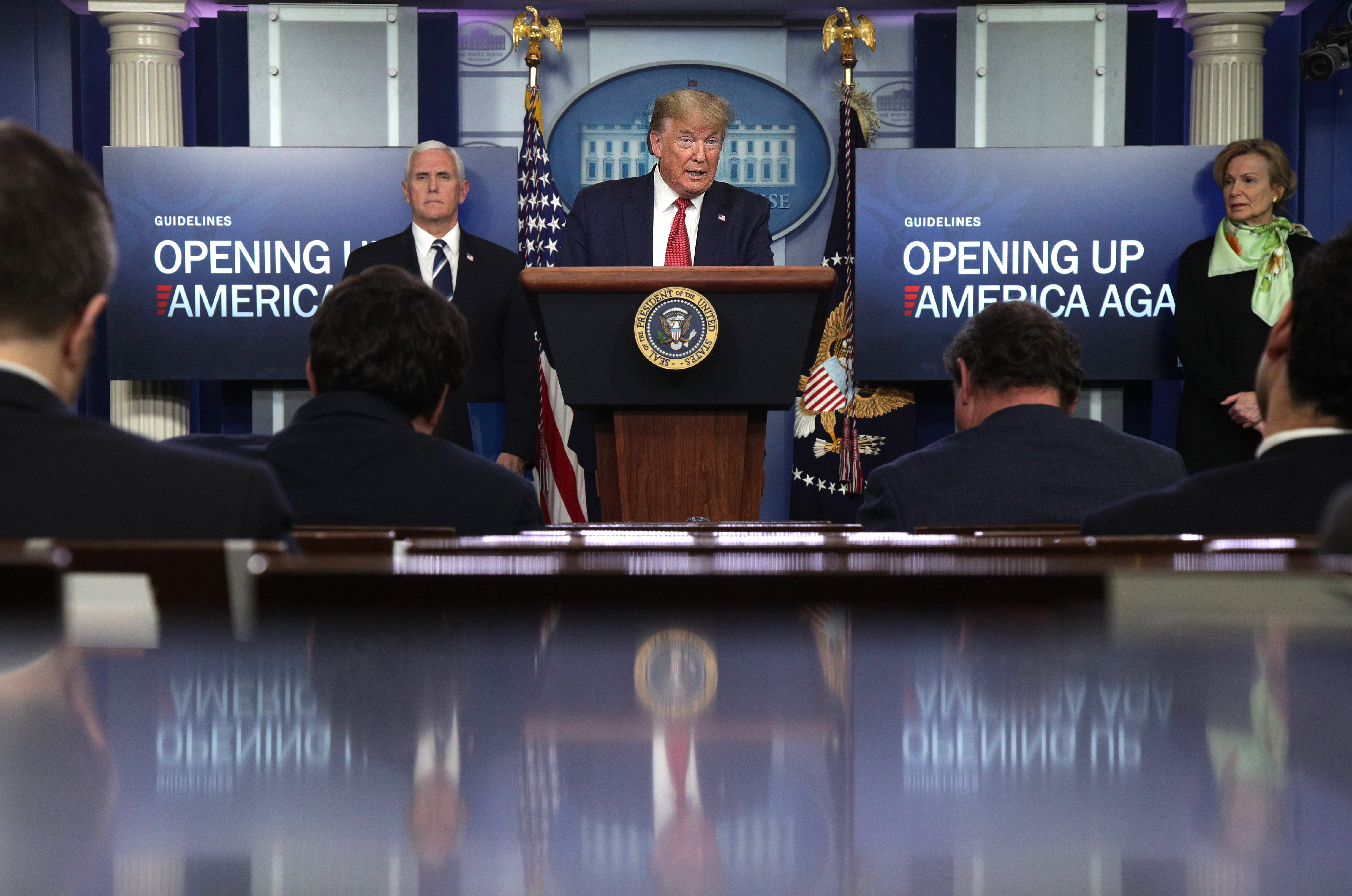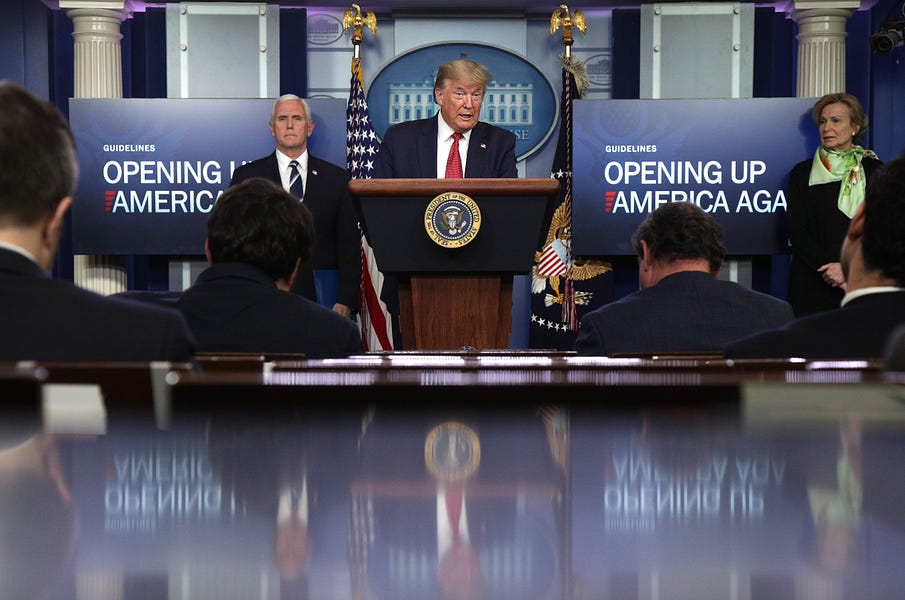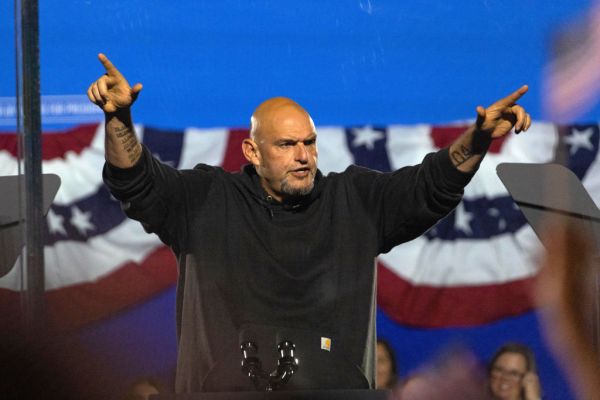Happy Friday. This is going to be the weekend we start the home workout videos. Promise.
Quick Hits: Today’s Top Stories
-
As of Thursday night, there are now 671,151 confirmed cases of COVID-19 in the United States (a 5.2 percent increase from yesterday) and 33,268 deaths (a 7.9 percent increase from yesterday), according to the Johns Hopkins University COVID-19 Dashboard, leading to a mortality rate among confirmed cases of 5 percent (the true mortality rate is difficult to calculate due to incomplete testing regimens). Of 3,401,064 coronavirus tests conducted in the United States, 19.7 percent have come back positive. There are 108,942 Americans hospitalized with COVID-19 complications (a 4.9 percent increase from yesterday), while 56,017 have recovered from the virus (a 6.4 percent increase from yesterday). Several of you noticed a sharp spike in deaths in yesterday’s edition—while we’re still at or around the peak in our curve, the Johns Hopkins official death count reflects retroactive revisions and slight tweaks in reporting methodology in recent days.
-
A Chicago hospital is seeing some early success in treating coronavirus patients with an antiviral medicine from Gilead Science called remdesivir. The drug is currently in two Phase 3 trials and not yet approved by the Food and Drug Administration, but STAT News is reporting that only two of 125 coronavirus patients (113 of whom were severely ill) in one of the trials have died after being treated with daily infusions of remdesivir.
-
Another 5.2 million jobless claims were filed last week, bringing the total over the past month to more than 20 million. More jobs have been lost in that timeframe than had been gained since the Great Recession.
-
Mark Zuckerberg announced Facebook would allow most employees to work from home throughout the summer—even if local restrictions are lifted—and that the company is canceling all scheduled events of 50 people or more through at least June 2021.
-
The Senate adjourned for the week on Thursday without reaching a deal to increase funds for the now-depleted small-business loan Paycheck Protection Program. The Senate will reconvene on Monday.
-
A federal judge denied former Trump aide Roger Stone’s request for a retrial over what Stone and his legal team argued was a tainted jury. The gag order on Stone has been lifted, however, and he is expected to begin his 40-month sentence in as soon as two weeks.
-
According to a Pew Research Center survey, 66 percent of Americans expressed concern that restrictions on public activity will be lifted too quickly and 73 percent of Americans believe the worst is yet to come. Meanwhile, 65 percent say President Trump was too slow in responding to the coronavirus threat.
Our Back-to-Work Road Map

When President Trump announced Wednesday that he would unveil the White House’s road map to getting America back to work the following day, there was plenty of reason to be nervous. Trump had spent the week both insisting that the time had come to open the country back up and stating repeatedly and in no uncertain terms that the decision to do so belonged to him. Would the president really try to force the economy back into motion over the objection of the states, in defiance of both medical consensus and the Constitution? It hardly seemed possible.
Then, on Thursday afternoon, the president kicked off his daily press briefing—and it was as though none of that had ever happened. He still spoke of his deep desire to bring an end to the economic devastation of the shutdown: “There’s death and there’s problems in staying home too. It’s not just ‘isn’t it wonderful to stay at home.’ They’re suffering. This country wasn’t built on that principle.” But the road map he and his top pandemic experts rolled out was the antithesis of his rhetoric from earlier in the week: slow, cautious, and—most of all—deferential to governors’ individual decisions about how quickly to open their states back up.
The plan bears major similarities to the one suggested last month by Dr. Scott Gottlieb of the American Enterprise Institute, which we discussed at length a few weeks back. It sets up criteria for a state to consider itself “prepared” to reopen: Does it have a sufficient virus testing operation in place? Sufficient protective equipment for doctors and nurses? Sufficient ICU equipment and hospital beds? It also establishes “gating” benchmarks for how far the virus should have receded in a state before reopening can be considered: Have influenza-like illnesses and documented COVID cases been trending downward over a 14-day period? Is the state able to treat all patients without resorting to crisis care and test its health care workers sufficiently?
Once a state has satisfied the gating criteria, reopening can proceed in three stages, with states proceeding from one stage to the next if they are able to continue meeting the criteria for a period of time under more open conditions.
Under Phase One: People can begin to return to work gradually (though telework should still be encouraged), non-essential travel should still be minimized, schools and other youth activities should remain closed, larger venues like churches and sit-down restaurants can partially reopen, and elective surgeries can resume. Meanwhile, vulnerable individuals and their families should continue to shelter in place.
Under Phase Two: More public spaces can open up, although gatherings of more than 50 people should still be avoided. Schools and daycares can resume, as can non-essential travel.
Under Phase Three: Even vulnerable individuals will be able to begin to venture back into society—albeit while continuing to practice physical distancing measures. Workplaces can return to unrestricted staffing, and people can begin again to visit senior care facilities and hospitals.
At Thursday’s briefing, Dr. Anthony Fauci cautioned that life will not be able to return totally to normal until we have effective coronavirus therapeutics or a vaccine. “No matter what phase you’re in, there are certain fundamental things that we’ve done that are not like it was in September and October. You want to call it the new normal, you can call it whatever you want. … It may very well be, as we go this cycle around, that there’ll be this virus that wants to come back to us. I think we’ll be able to handle that.”
But the road map offered hope that some mildly affected states may be able to begin creeping back toward work as early as this week. “I heard from a number of governors that said they’re in very good shape,” Trump said Thursday. “They will be able to go literally tomorrow, yes. Because they’ve met all of the guidelines if you go back.”
It’s important to note that this is only a road map. All the logistical challenges for how states are to get to the point where they meet the gating criteria—in particular, how they are to reach sufficient quantities of coronavirus testing—remain.
But simply having a road map is an enormously helpful step. Two weeks ago, virologist Dr. Paul Offit told us that the lack of such benchmarks was holding us back by not presenting people with an end goal for their social distancing efforts. “We don’t really have a good federal policy in place to sort of let us know what we’re looking for, to determine whether or not people go back to school, people go back to work,” he said. “We lack a federal policy.”
Well, we have such a policy now. The light at the end of the tunnel is there. All we have to do is keep slogging toward it.
How We Learned to Stop Worrying and Love Absentee Voting
Just more than 1.5 million people voted in Wisconsin’s election last week—or roughly 34 percent of their voting age population. While lower than turnout in 2016, in which both parties had competitive primary elections, turnout this year was virtually tied with 2008 and nearly 10 points higher than 2012. And despite the fact that so many polling locations around the state were closed for in-person voting, more than 1 million absentee ballots were returned, accounting for more than 70 percent of the votes cast. By way of comparison, fewer than 30 percent of Wisconsinites voted absentee for the 2016 general election and only 10 percent did in the primary that year.
If Wisconsin is any indication, this means the November election could involve more mail and absentee voting than any election in history. Rachel Kleinfeld, a senior fellow in the Democracy, Conflict, and Governance program at the Carnegie Endowment and a member of the bipartisan National Task Force on Election Crisis, answers some of our most pressing questions on the website today.
Is it feasible?
As Kleinfeld tells us, voting by mail is already a reality—in 2016, nearly a quarter of the electorate voted absentee. In about two-thirds of states, voters either receive ballots automatically or may request an absentee ballot without offering a reason. And while she acknowledges that states where absentee voting has been most restricted should not try to move entirely to a vote-by-mail system, high-density municipalities where coronavirus could spread quickly could enable no-excuse absentee voting or even mail out ballots. Rural areas could offer more drive-through locations. All these states should offer, or broaden, early voting hours to enable voters to space themselves at the polls.
Is it fraud-proof?
Well, no. But according to Kleinfeld, the good news is that states that have moved entirely to vote-by-mail have some of the lowest numbers of voter fraud. Ballots have bar codes so that each voter can receive only one; signature matching software or trained professionals ensure that the signature on the ballot matches that on the vote. In states where the match is imperfect, the government must notify individual voters and allow them the opportunity for verification. It is in states where absentee ballots are rare and anomalous to the mass voting system where most fraud has taken place (though still remarkably low), and states that moved toward greater vote by mail systems and invested in the proper equipment to ensure voter verification would be able to better detect and prevent illegal ballot harvesting.
Is it partisan?
It doesn’t appear to be. Kleinfeld notes that states that have embraced broad absentee voting and vote by mail don’t break down along partisan lines. Red and blue states in the West have moved to these systems. The biggest demographic who vote by mail are the elderly, who tend to vote Republican. They are also the most likely to be scared away from the polls by COVID-19. However, studies of vote by mail in Colorado and Utah found increased turnout from the young, the very old, and nonvoters, benefitting, on the whole, no party in particular.
Worth Your Time
-
Across the country, nurses and doctors represent the frontlines in our fight against this virus. Blake Paterson—reporter for the Advocate in Baton Rouge and friend of The Morning Dispatch—shadowed several of these medical workers at Baton Rouge General in Louisiana, one of the states hardest hit by COVID-19. “The nurses come from all different specialties and many had never worked at Mid City. They didn’t know where to go. They didn’t know where anything was. And with everyone wearing surgical mask, goggles, and bonnets, they could barely see each other’s faces. ‘Most of us don’t even know each other’s names,’ one nurse said ‘You just learn what their eyeballs look like and that’s about it.’” Check it out the full piece here.
-
In a world without campaign rallies, party conventions, and door-to-door canvassing, the internet is going to play an even bigger role in Election 2020 than many experts had predicted. The New York Times’ Kevin Roose took a look at the Trump and Biden campaigns’ digital assets, and found the incumbent with an enormous advantage; Donald Trump has 106 million combined followers on Twitter and Facebook compared to Joe Biden’s meager 6.7 million. Will it matter?
-
This Businessweek investigation into the cruise industry’s response to coronavirus by Austin Carr and Chris Palmeri is incredible. “Passengers noticed new hand sanitizer stations and crew members wearing gloves, but life on the Grand Princess, which advertises 1,301 cabins, 20 restaurants and lounges, about a dozen shops, and four freshwater swimming pools, otherwise went on as normal. Guests prepared for a ukulele concert, played bridge at shared tables, and took line-dancing classes,” in early March, they write. “That night, Laurie Miller and her husband, John, attended True or Moo, a show featuring an emcee in a cow costume; the following morning, John joined about 200 other passengers in the ship’s Broadway-style theater for a lecture on Clint Eastwood movies. ‘I’m surprised they’re even letting this event happen,’ he whispered to a nearby friend. ‘This is a big crowd.’”
Presented Without Comment
Also Presented Without Comment
Also Also Presented Without Comment
Something Fun
We understand why you love going on walks now, too. And eating food out of a can.
Toeing the Company Line
-
The latest Advisory Opinions podcast is out and features Sarah and David bantering about the Wisconsin primary results, regulatory taking in Pennsylvania, the adjournment clause, Joe Biden’s veepstakes, and much more. Tune in here.
-
President Trump has suspended funding of the World Health Organization while his administration reviews WHO’s coronavirus response. AEI’s Lyman Stone wrote a piece for the site yesterday arguing this suspension of funding should only be the beginning of the U.S.’s response if Trump is seriously interested in reforming WHO. “There are many diplomatic battles which the United States will not win even if we throw all of our resources at them,” he writes. “But we can win this one.”
-
In his column today, Jonah takes issue with Bill Bennett’s assertion that our coronavirus response has been overkill. “He wants Americans to man up and respond with the sort of courage we showed after the 9/11 attacks. … [Th]e idea that Americans are panicky fraidy-cats strikes me as grossly unfair.”
-
In a bonus edition of Vital Interests, Tom Joscelyn reviews the executive summary of State Department annual report on arms control. All the usual suspects appear: China, Russia, Syria, North Korea, and Iran.
Let Us Know
As we detailed above, we’re still a ways away from any sort of normalcy. But at least we have an idea of what the path forward will look like, even if the timeline is still lacking.
We want to know from you, though: What are some activities you participated in pre-coronavirus that you will not be taking part in again until you’ve been vaccinated against COVID-19?
Reporting by Declan Garvey (@declanpgarvey), Andrew Egger (@EggerDC), Alec Dent (@Alec_Dent), Sarah Isgur (@whignewtons), and Steve Hayes (@stephenfhayes).






Please note that we at The Dispatch hold ourselves, our work, and our commenters to a higher standard than other places on the internet. We welcome comments that foster genuine debate or discussion—including comments critical of us or our work—but responses that include ad hominem attacks on fellow Dispatch members or are intended to stoke fear and anger may be moderated.
You are currently using a limited time guest pass and do not have access to commenting. Consider subscribing to join the conversation.
With your membership, you only have the ability to comment on The Morning Dispatch articles. Consider upgrading to join the conversation everywhere.